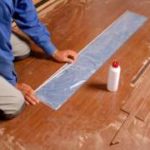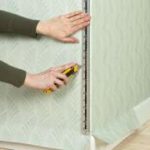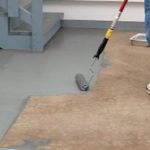Patching hardwood floors is a process that is not hard to perform with your own hands in case of knowing the technology tips and tricks.
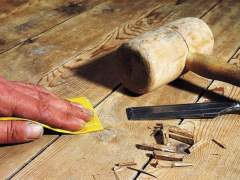 Hardwood flooring is a fairly long-lasting coating that can serve homeowners for many decades not requiring any repair – often it needs only a periodical restoration re-finish. But sometimes patching hardwood floors becomes inevitable. Here is the most important tips on how to patch hardwood floor with your own hands in case you have smaller damages.
Hardwood flooring is a fairly long-lasting coating that can serve homeowners for many decades not requiring any repair – often it needs only a periodical restoration re-finish. But sometimes patching hardwood floors becomes inevitable. Here is the most important tips on how to patch hardwood floor with your own hands in case you have smaller damages.
The possible reasons of damages of hardwood flooring:
- initially, the hardwood was covered with a low-grade varnish;
- improper varnish technology;
- wet-temperature regime in the room (it is necessary to comply with the humidity of 45-60%);
- too wet mopping of the floor;
- walking in high-heeled shoes;
- moving furniture that has no leg pads;
- chairs and tables on wheels without special plastic mat;
- being laid in rooms with high levels of humidity and water penetration into the timber (kitchens, bathrooms).
The first step to fix holes of a small size is work with lacquer. The order of works is the following:
- Treat the top layer of lacquer – perform grinding and smoothing;
- Then all the cracks and small holes with mastic;
- Perform varnishing of the wood – at least three layers.
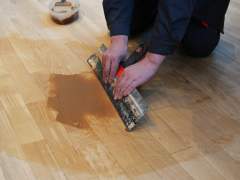 Sometimes only wax coating needs restoration. It is so, if you have:
Sometimes only wax coating needs restoration. It is so, if you have:
- the formation of oily stains on the surface of the flooring;
- timber damage – cracks, scratches, holes from fallen heavy impact or sharp objects;
- numerous scratches left after moving the furniture and walking in high-heeled shoes (this is the most common problem);
- accumulation of dirt in the cracks and structural strips of wood.
Patching hardwood with oil
The order of works is the following:
- designated damage must be degreased and cleaned of dirt;
- surface is cleaned with micro sandpaper in the direction of the wood grain or to be polished using a special grinding machine;
- then apply special wax – you should hide all the micro-depressions and cracks;
- after this, apply oil-wax composition.
Lag-related problems
They are the following:
- the lags have not dried during the installation and then;
- the lags were not attached tightly to the lower base;
- If the house was built new, the wet screed may influence on the lags absorbing moisture from, then, the over time the wood is deformed by changing its wet mode;
- in the rooms with too humid mode the lags change shape as a result of swelling from moisture.
Patching wood floors – the technology
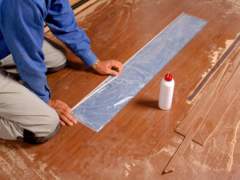 In this case, a necessary measure is a complete patching – the replacement of the lag and the flooring segment. If the flooring was laid on a dry screed with mastic asphalt, there is a possibility that very soon – in several years – the mastic will dry and reduce in thickness. There will be blisters and bumps. Mastic crumbles into small particles of dirt. Board begins to “walk itself” on the uneven base.
In this case, a necessary measure is a complete patching – the replacement of the lag and the flooring segment. If the flooring was laid on a dry screed with mastic asphalt, there is a possibility that very soon – in several years – the mastic will dry and reduce in thickness. There will be blisters and bumps. Mastic crumbles into small particles of dirt. Board begins to “walk itself” on the uneven base.
The steps of patching:
- Partially disassemble the hardwood board and update the mastic coating.
- Remove the entire damaged board.
- Pour screed on a special adhesive.
- Fix the floor with screws, sand and varnish it.
Proper care to prevent restoration or patching
The relative humidity of the room should be within the range 45-60%
- The temperature should be not lower than 60 ?F and not more than 80 ?F – with these parameters, timber does not change its properties and shape;
- The legs of all furniture should have special soft pads – in this case the risk of scratches significantly reduces;
 Under the furniture items on wheels (office chairs) you must lay plastic transparent mats – they do not violate the visual harmony of the home, but totally protect the hardwood against scratches;
Under the furniture items on wheels (office chairs) you must lay plastic transparent mats – they do not violate the visual harmony of the home, but totally protect the hardwood against scratches;- Cleaning should be dry or partially dry – perhaps with a damp cloth, it may be a bit wetted (no puddles and wet streaks);
- Periodically update the oil layer of hardwood (the oil method mentioned above) – the more often you rub the flooring with compositions, the faster it will maximize water repellent;
- All the timber pores are clogged with wax – it will cease to absorb the dirt outside;
- Use special household cleaning products.
